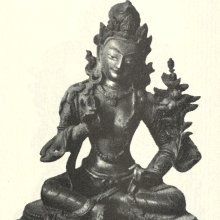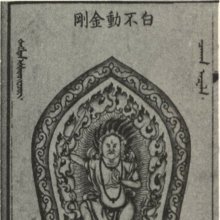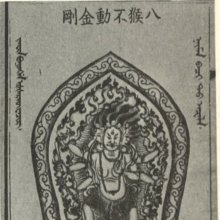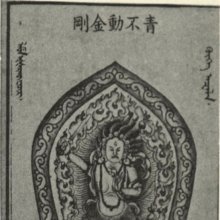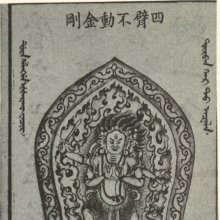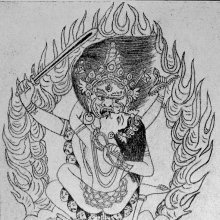Acala, Acalā: 40 definitions
Introduction:
Acala means something in Buddhism, Pali, Hinduism, Sanskrit, Jainism, Prakrit, Marathi, Hindi. If you want to know the exact meaning, history, etymology or English translation of this term then check out the descriptions on this page. Add your comment or reference to a book if you want to contribute to this summary article.
Alternative spellings of this word include Achala.
Images (photo gallery)
(+2 more images available)
In Hinduism
Vaishnavism (Vaishava dharma)
Source: humindian: 108 names of Lord KrishnaOne of the 108 names of Krishna; Meaning: "Still Lord"

Vaishnava (वैष्णव, vaiṣṇava) or vaishnavism (vaiṣṇavism) represents a tradition of Hinduism worshipping Vishnu as the supreme Lord. Similar to the Shaktism and Shaivism traditions, Vaishnavism also developed as an individual movement, famous for its exposition of the dashavatara (‘ten avatars of Vishnu’).
Purana and Itihasa (epic history)
Source: archive.org: Puranic Encyclopedia1) Acala (अचल).—General. Acala was the son of Subala, a King of Gāndhāra. He was Śakuni’s brother and a heroic Charioteer on the side of the Kauravas. (Mahābhārata Udyoga Parva, Chapter 168, Verse 1).
Acala had also taken part in Yudhiṣṭhira’s Rājasūya. (A very expensive sacrifice—yāga—performed by an emperor.) (Mahābhārata Sabhā Parva, Chapter 34, Verse 7).
Acala had a brother named Vṛṣaka. In the battle between the Kauravas and Pāṇḍavas, Arjuna killed Acala and Vṛṣaka. (Mahābhārata Droṇa Parva, Chapter 30, Verse 11).
One night Vyāsa summoned the departed holy souls and Acala also was among them. (Mahābhārata Āśvamedhika Parva, Chapter 32, Verse 12). (See full article at Story of Acala from the Puranic encyclopaedia by Vettam Mani)
2) Acala (अचल).—Name of a bull. Among the pārṣadas of Skanda we see the bull named Acala. (Mahābhārata Śalya Parva, Chapter 85, Verse 74).
3) Acala (अचल).—An epithet of Mahāviṣṇu. Among the thousand names of Mahāviṣṇu we see the name Acala also. (Mahābhārata Anuśāsana Parva, Chapter 149, Verse 92).
4) Acala (अचल).—Subrahmaṇya, who was born from Śiva’s semen which fell into the fire, was made Commander-in-Chief (Generalissimo) by the gods to kill Tārakāsura. A large number of warriors and mothers were assigned to assist him. A woman named Acalā was included among those mothers. (Mahābhārata Śalya Parva, Chapter 40, Verse 14).
Source: Cologne Digital Sanskrit Dictionaries: The Purana Index1a) Acala (अचल).—ety.—immovable, hence a mountain.*
- * Brahmāṇḍa-purāṇa II. 7. 11.
1b) The name of Bhairava in the kiricakra.*
- * Brahmāṇḍa-purāṇa IV. 20. 82.
1c) The son of Mahīnetra; ruled for 32 years.*
- * Matsya-purāṇa 271. 28.
1d) A devaṛṣi.*
- * Vāyu-purāṇa 61. 84.
Acala (अचल) is a name mentioned in the Mahābhārata (cf. II.31.7, VIII.4.39, IX.44.69) and represents one of the many proper names used for people and places. Note: The Mahābhārata (mentioning Acala) is a Sanskrit epic poem consisting of 100,000 ślokas (metrical verses) and is over 2000 years old.

The Purana (पुराण, purāṇas) refers to Sanskrit literature preserving ancient India’s vast cultural history, including historical legends, religious ceremonies, various arts and sciences. The eighteen mahapuranas total over 400,000 shlokas (metrical couplets) and date to at least several centuries BCE.
Yoga (school of philosophy)
Source: Wisdom Library: YogaAcala is one of the eighty-four Siddhas associated with eighty-four Yogic postures (āsanas), according to popular tradition in Jodhpur, Rājasthān. These posture-performing Siddhas are drawn from illustrative sources known as the Nava-nātha-caurāsī-siddha from Vȧrāṇasī and the Nava-nātha-caruāsī-siddha-bālāsundarī-yogamāyā from Puṇe. They bear some similarity between the eighty-four Siddhas painted on the walls of the sanctum of the temple in Mahāmandir.
The names of these Siddhas (e.g., Acala) to 19th-century inscription on a painting from Jodhpur, which is labelled as “Maharaja Mansing and eighty-four Yogis”. The association of Siddhas with yogis reveals the tradition of seeing Matsyendra and his disciple Gorakṣa as the founders of haṭhayoga.
Source: ORA: Amanaska (king of all yogas): A Critical Edition and Annotated Translation by Jason BirchAcala (अचल) refers to “that which has no movement”, and is used to describe Samādhi and Paratattva (highest reality), according to the Amanaska Yoga treatise which deals absorption, yogic powers and liberation.—The Amanaska referred to (or qualified) Samādhi with several terms, which are all negative; [e.g., it has no movement (acala);] [...] The fact that such terminology is found in the Amanaska indicates that descriptions of Śiva and the void-like meditative states in Mantramargic Śaivism, were the basis of the descriptions of Samādhi and Paratattva (the highest reality) in this treatise. The Amanaska Yoga was consistent with the Pātañjala Yogaśāstra’s definition of Yoga, yet it described Samādhi in terms different to those of Pātañjalayoga; such as Acala—“that which has no movement”.

Yoga is originally considered a branch of Hindu philosophy (astika), but both ancient and modern Yoga combine the physical, mental and spiritual. Yoga teaches various physical techniques also known as āsanas (postures), used for various purposes (eg., meditation, contemplation, relaxation).
Chandas (prosody, study of Sanskrit metres)
Source: Shodhganga: a concise history of Sanskrit Chanda literatureAcalā (अचला) is the name of a Sanskrit metre (chandas) to which Hemacandra (1088-1173 C.E.) assigned the alternative name of Suvaktrā in his auto-commentary on the second chapter of the Chandonuśāsana. Hemacandra gives these alternative names for the metres by other authorities (like Bharata), even though the number of gaṇas or letters do not differ.

Chandas (छन्दस्) refers to Sanskrit prosody and represents one of the six Vedangas (auxiliary disciplines belonging to the study of the Vedas). The science of prosody (chandas-shastra) focusses on the study of the poetic meters such as the commonly known twenty-six metres mentioned by Pingalas.
Ayurveda (science of life)
Nighantu (Synonyms and Characteristics of Drugs and technical terms)
Source: Wisdom Library: Raj NighantuAcalā (अचला) refers to “earth” and is mentioned in a list of 53 synonyms for dharaṇi (“earth”), according to the second chapter (dharaṇyādi-varga) of the 13th-century Raj Nighantu or Rājanighaṇṭu (an Ayurvedic encyclopedia). The Dharaṇyādi-varga covers the lands, soil [viz., Acalā], mountains, jungles and vegetation’s relations between trees and plants and substances, with their various kinds.

Āyurveda (आयुर्वेद, ayurveda) is a branch of Indian science dealing with medicine, herbalism, taxology, anatomy, surgery, alchemy and related topics. Traditional practice of Āyurveda in ancient India dates back to at least the first millenium BC. Literature is commonly written in Sanskrit using various poetic metres.
Shilpashastra (iconography)
Source: Shodhganga: The significance of the mūla-beras (śilpa)Acala (अचल) refers to one of the major divisions of Hindu images, as defined in the texts dealing with śilpa (arts and crafs), known as śilpaśāstras.—The Hindu images are divided into three classes–chala (movable), achala (immovable), and chalāchala (movable-immovable). The immovable (acala) images cannot be moved from the particular place where they are installed. They are made up of mṛnmaya (terracotta) or sārkara (laterite), and sauyaja (stucco). The dhruva or yoga-bera or mūla-vigraha that are permanently established in a shrine come under this category.

Shilpashastra (शिल्पशास्त्र, śilpaśāstra) represents the ancient Indian science (shastra) of creative arts (shilpa) such as sculpture, iconography and painting. Closely related to Vastushastra (architecture), they often share the same literature.
Pancaratra (worship of Nārāyaṇa)
Source: University of Vienna: Sudarśana's Worship at the Royal Court According to the AhirbudhnyasaṃhitāAcala (अचल) refers to a “mountain”, according to the Ahirbudhnyasaṃhitā, belonging to the Pāñcarātra tradition which deals with theology, rituals, iconography, narrative mythology and others.—Accordingly, “[...] [The demons born of] the aggressive magic of [his] enemies, having failed to take hold of him, frightened will possess the performer [of the ritual], like a river[’s fury] blocked by a mountain (acala-āhata—āpagevācalāhatā). Droughts will end and enemies will run away. In his kingdom there will not be dangers in the form of untimely deaths, wild animals, beasts of prey, thieves, illnesses etc. and strength shall reside in his lineage”.

Pancaratra (पाञ्चरात्र, pāñcarātra) represents a tradition of Hinduism where Narayana is revered and worshipped. Closeley related to Vaishnavism, the Pancaratra literature includes various Agamas and tantras incorporating many Vaishnava philosophies.
Ganitashastra (Mathematics and Algebra)
Source: archive.org: Hindu MathematicsAcala (अचल) represents the number 7 (seven) in the “word-numeral system” (bhūtasaṃkhyā), which was used in Sanskrit texts dealing with astronomy, mathematics, metrics, as well as in the dates of inscriptions and manuscripts in ancient Indian literature.—A system of expressing numbers by means of words arranged as in the place-value notation was developed and perfected in India in the early centuries of the Christian era. In this system the numerals [e.g., 7—acala] are expressed by names of things, beings or concepts, which, naturally or in accordance with the teaching of the Śāstras, connote numbers.

Ganitashastra (शिल्पशास्त्र, gaṇitaśāstra) refers to the ancient Indian science of mathematics, algebra, number theory, arithmetic, etc. Closely allied with astronomy, both were commonly taught and studied in universities, even since the 1st millennium BCE. Ganita-shastra also includes ritualistic math-books such as the Shulba-sutras.
Shaivism (Shaiva philosophy)
Source: SOAS University of London: Protective Rites in the Netra TantraAcala (अचल) refers to “immovable (quartz)”, according to the Netratantra of Kṣemarāja: a Śaiva text from the 9th century in which Śiva (Bhairava) teaches Pārvatī topics such as metaphysics, cosmology, and soteriology.—Accordingly, [verse 10.7cd-17ab, while describing the worship of Bhairavī and Bhairava]—“[...] One should always worship [in times of] peace and prosperity, to suppress sickness and vice, [which are] the root cause of wasting away, [and] for the protection of cows, Brahmins, and men. One meditates on [Bhairava] as having equal radiance to snow, jasmine, the moon, or pearls. [He is] as clear as the curved moon and similar to immovable quartz (sphaṭika-acala-saṃnibha). [He is] clear like the burning of the end of time, resembles a flower on the sacred tree, appears red like innumerable suns or, rather, red like a lotus. [...]”.

Shaiva (शैव, śaiva) or Shaivism (śaivism) represents a tradition of Hinduism worshiping Shiva as the supreme being. Closely related to Shaktism, Shaiva literature includes a range of scriptures, including Tantras, while the root of this tradition may be traced back to the ancient Vedas.
In Buddhism
Theravada (major branch of Buddhism)
Source: Pali Kanon: Pali Proper Names1. Assistant to the architect of the Maha Thupa. MT.535.
2. One of the eminent monks present at the foundation of the Maha Thupa. MT.526.
Theravāda is a major branch of Buddhism having the the Pali canon (tipitaka) as their canonical literature, which includes the vinaya-pitaka (monastic rules), the sutta-pitaka (Buddhist sermons) and the abhidhamma-pitaka (philosophy and psychology).
Mahayana (major branch of Buddhism)
Source: Wisdom Library: Maha Prajnaparamita Sastra1) Acala (अचल) refers to “(that which is) motionless”, according to Mahāprajñāpāramitāśāstra (chapter 4).—Accordingly, “[Question: Why is the Buddha called Samyaksaṃbuddha?]—[Answer]: [...] Furthermore, he knows that all the Dharmas are truly unchangeable (abhedya), without increase or decrease. Why are they unchangeable? When the functioning of the mind (citta-pravṛtti) is stopped (sthita) and destroyed (niruddha), when the path of speech (abhilāpamārga) is cut, he understands that Dharmas are motionless (acala), like nirvāṇa itself. This is why he is called Samyaksaṃbuddha”.
2) Acalā (अचला) refers to the unshakeable one” and represents one of the Bodhisattva bhūmis, according to the 2nd century Mahāprajñāpāramitāśāstra chapter 38. Accordingly, “being supported by these nine indriyas, the Bodhisattva will enter into the assurance of the ultimate attainment of enlightenment of the bodhisattva (bodhisattva-niyāma)”. In other words, the Bodhisattva will enter into the eighth Bodhisattva bhūmi, the Acalā, the “unshakeable one”. According to most sources, the Acalā marks an important turning point in the Bodhisattva’s career [...].
3) Acalā (अचला) or Acalābhūmi refers to the “unshakable bhūmi” and represents one of the ten Bodhisattva grounds (bodhisattabhūmi), according to the Daśabhūmikasūtra, or Daśabhūmīśvara, as mentioned in the 2nd century Mahāprajñāpāramitāśāstra chapter 52.—Acalā-bhūmi is also known as “mi gyo ba, pou tong”.
The Bodhisattva-mahāsattva in the eighth bhūmi (acalā) must completely fulfill five Dharmas.
What are these five?
- Penetrating the minds of all beings.
- Playing with the superknowledges.
- Seeing the buddha-fields.
- Constructing his own field on the model of the buddha-fields previously seen.
- Seeing the body of the Buddhas in conformity with reality.
Those are the five Dharmas to be completely fulfilled. [...]
Furthermore, O Subhūti, the Bodhisattva-mahāsattva in the eighth ground (acalā-bhūmi) should completely fulfill five dharmas, namely:
- Knowing the extent of the spiritual faculties.
- Purifying the buddha-field.
- Concentrating oneself in the magic-like concentration.
- Perpetual concentration.
- According to such and such a degree of achievement that the roots of good of beings have, the Bodhisattva assumes such and such a form of existence.
These, O Subhūti, are the five Dharmas which the Bodhisattva-Mahāsattva residing in the eighth ground (acalā-bhūmi) must fulfill completely.
Source: archive.org: Bulletin of the French School of the Far East (volume 5)Acala (अचल) is the name of a Kumbhāṇḍa appointed as one of the Divine protector deities of Kinnara, according to chapter 17 of the Candragarbha: the 55th section of the Mahāsaṃnipāta-sūtra, a large compilation of Sūtras (texts) in Mahāyāna Buddhism partly available in Sanskrit, Tibetan and Chinese.—In the Candragarbhasūtra, the Bhagavat invites all classes of Gods and Deities to protect the Law [dharma?] and the faithful in their respective kingdoms of Jambudvīpa [e.g., the Kumbhāṇḍa Acala in Kinnara], resembling the time of the past Buddhas.

Mahayana (महायान, mahāyāna) is a major branch of Buddhism focusing on the path of a Bodhisattva (spiritual aspirants/ enlightened beings). Extant literature is vast and primarely composed in the Sanskrit language. There are many sūtras of which some of the earliest are the various Prajñāpāramitā sūtras.
Tibetan Buddhism (Vajrayana or tantric Buddhism)
Source: archive.org: The Indian Buddhist Iconography1) Acala (अचल) is another name for Caṇḍamahāroṣaṇa or Caṇḍaroṣaṇa: one of the various emanations of Akṣobhya having their Sādhana described in the 5th-century Sādhanamālā (a collection of sādhana texts that contain detailed instructions for rituals).—His Colour is yellow; his Symbols are the sword and tarjanīpāśa; he has two arms.—Caṇḍaroṣaṇa is also called Mahācaṇḍaroṣaṇa, Caṇḍamahāroṣaṇa and Acala. Four Sādhanas are devoted to his worship and he is always represented in yab-yum. Prabhākarakīrti is said to be the author of one of the Sādhanas the major portion of which is is verse.
2) Acala (अचल) presides over the Īśāna-corner and represents one of the ten deities of the quarters (Dikpāla) commonly depicted in Buddhist Iconography, and mentioned in the 11th-century Niṣpannayogāvalī of Mahāpaṇḍita Abhayākara.—His Colour is blue; he has three faces and six arms.—Acala is the eighth deity in the series, and is regarded as the presiding deity of the Īśāna-corner. His form is several times described in the Niṣpannayogāvalī. It is probable that this deity is the same as Acala who is known as Caṇḍaroṣaṇa.
Acala is described in the Niṣpannayogāvalī (mañjuvajra-maṇḍala) as follows:—
“In the Īśāna corner there is Acala with blue complexion. His three faces are blue, white and red. He holds the sword, the vajra, the jewel and the lotus”.
[In the vajrahūṃkāra-maṇḍala he is given the name of Vajrabhīṣaṇa, but in the dharmadhātuvagīśvara-maṇḍala his name is Trailokyavijaya.]
3) Acalā (अचला) or Acalābhūmi refers to one of twelve Bhūmi Goddesses, according to the 11th-century Niṣpannayogāvalī of Mahāpaṇḍita Abhayākara.—Her Colour is white; her Symbol is a vajra on lotus; she has two arms.
Acalā is described in the Niṣpannayogāvalī (dharmadhātuvāgīśvara-maṇḍala) as follows:—
Source: academia.edu: The Structure and Meanings of the Heruka Maṇḍala“Acalā is of the colour of the moon in autumn, and holds with pride in her left hand the stalk of a lotus over which is placed the five-thonged vajra on the disc of the moon”.
[These twelve bhūmis [viz., Acalā] are two-armed and hold in the right hand the vajra and in the left their own weapons or signs.]
Acala (अचल) is the name of a Vīra (hero) who, together with the Ḍākinī named Acalī forms one of the 36 pairs situated in the Hṛdayacakra, according to the 10th century Ḍākārṇava chapter 15. Accordingly, the hṛdayacakra refers to one of the four divisions of the sahaja-puṭa (‘innate layer’), situated within the padma (lotus) in the middle of the Herukamaṇḍala. The 36 pairs of Ḍākinīs and Vīras [viz., Acala] are reddish yellow in color; they each have one face and four arms; they hold a skull bowl, a skull staff, a small drum, and a knife.

Tibetan Buddhism includes schools such as Nyingma, Kadampa, Kagyu and Gelug. Their primary canon of literature is divided in two broad categories: The Kangyur, which consists of Buddha’s words, and the Tengyur, which includes commentaries from various sources. Esotericism and tantra techniques (vajrayāna) are collected indepently.
General definition (in Buddhism)
Source: Wisdom Library: Dharma-samgraha1) Acalā (अचला, “immovable”) or Acalābhūmi refers to the eighth of the “ten stages of the Bodhisattva” (bhūmi) as defined in the Dharma-saṃgraha (section 64). The Dharma-samgraha (Dharmasangraha) is an extensive glossary of Buddhist technical terms in Sanskrit (e.g., acalā). The work is attributed to Nagarjuna who lived around the 2nd century A.D. Arciṣmatī is also included in the “thirteen stages of the Bodhisattva” (trayodaśa-bhūmi).
2) Acalā (अचला, “mountain”) refers to one of the “seven lower regions” (pātāla ) as defined in the Dharma-saṃgraha (section 123).
In Jainism
General definition (in Jainism)
Source: Wisdom Library: JainismAcala (अचल) is the name of the first Baladeva according to Śvetāmbara, while the Digambara tradition mentions him as the second Baladeva. Jain legends describe nine such Baladevas (“gentle heroes”) usually appearing together with their “violent” twin-brothers known as the Vāsudevas. The legends of these twin-heroes usually involve their antagonistic counterpart known as the Prativāsudevas (anti-heroes).
The mother of Acala is known by the name Bhadrā according to the Samavāyāṅga-sūtra, and their stories are related in texts such as the Triṣaṣṭiśalākāpuruṣacarita (“the lives of the sixty-three illustrious persons”), a twelfth-century Śvetāmbara work by Hemacandra.
The nine Baladevas (such as Acala) are also known as Balabhadra and are further described in various Jain sources, such as the Bhagavatīsūtra and Jambūdvīpaprajñapti in Śvetāmbara, or the Tiloyapaṇṇatti and Ādipurāṇa in the Digambara tradition. The appearance of a Baladeva is described as follows: their body is of a white complexion, they wear a blue-black robe, and the mark of the palm-tree (tāla) is seen on their banners.
Source: archive.org: Trisastisalakapurusacaritra1) Acala (अचल), the son of Bhadrā, is one of the nine white Baladevas, according to chapter 1.6 [ādīśvara-caritra] of Hemacandra’s 11th century Triṣaṣṭiśalākāpuruṣacaritra: an ancient Sanskrit epic poem narrating the history and legends of sixty-three illustrious persons in Jainism. Accordingly: “[...] There will be nine white Baladevas, their (half-)brothers, sons of co-wives. [...] Acala, the son of Bhadrā, living for eighty-five lacs of years, will be the first Baladeva”.
2) Acala (अचल) is the name of one of the various childhood friends of Mahābala (son of king Bala from Vītaśoka), according to chapter 6.6 [śrī-mallinātha-caritra].—Accordingly:—“[...] A son, named Mahābala, having complete power, indicated by the dream of a lion, was borne to the king [i.e., Bala] by his wife Dhāriṇī. When he was grown, Mahābala married on one day five hundred princesses, Kamalaśrī and others. He had childhood-friends, Acala, Dharaṇa, Pūraṇa, Vasu, Vaiśravaṇa, and Abhicandra. [...]”.
3) Acala (प्रियदर्शन) is the name of a Cakrin from Ratnapura, according to the Jain Ramayana and chapter 7.8 [The abandonment of Sītā].—Accordingly, as Muni Deśabhūṣaṇa narrated to Rāma: “[...] After wandering for a long time in good conditions of existence because of the good inclination, in the city Ratnapura in West Videhā in Jambūdvīpa he [i.e., Ramaṇa] was born the son, named Priyadarśana, devoted to dharma, of Cakrin Acala by his chief-queen, Hariṇī. [...]”.
4) Acala (अचल) is the son of Kāñcanaprabhā and king Candrabhadra from Mathurā and is also the previous incarnation of Śrīdhara and Śatrughna, according chapter 7.8 [The abandonment of Sītā].
Source: SOAS Research Online: Prekṣā meditation: History and MethodsAcala (अचल) or “immovable” refers to one of the 46 qualities of the soul to be meditated on in the “Practice of Meditation on Liberated Souls (Siddhas)”, according to Jain texts like Ācārāṅga (5.6.123-140), Ṣaṭkhaṇḍāgama (13.5.4.31) and Samayasāra (1.49).—The pure soul can be recognised by meditation on its true nature, represented by the liberated souls of the Siddhas. The practice which leads to this realisation is meditation on the fact that attachment, aversion, passions and the influx of karmas, are ‘not mine’, that I am separate from them and consist of infinite knowledge, perception, conduct, spiritual energy, that I am the pure, enlightened, and everlasting soul. The qualities of the soul to be meditated on as truly mine are: [e.g., My soul is immovable (acala)] [...] The meditation on such extended fourty-five qualities of the pure soul presents the niśacaya-naya, which is aligned with Kundakunda’s approach.

Jainism is an Indian religion of Dharma whose doctrine revolves around harmlessness (ahimsa) towards every living being. The two major branches (Digambara and Svetambara) of Jainism stimulate self-control (or, shramana, ‘self-reliance’) and spiritual development through a path of peace for the soul to progess to the ultimate goal.
Languages of India and abroad
Pali-English dictionary
Source: BuddhaSasana: Concise Pali-English Dictionaryacala : (adj.) not moving; unshakeable.

Pali is the language of the Tipiṭaka, which is the sacred canon of Theravāda Buddhism and contains much of the Buddha’s speech. Closeley related to Sanskrit, both languages are used interchangeably between religions.
Marathi-English dictionary
Source: DDSA: The Molesworth Marathi and English Dictionaryacala (अचल).—a (S) Fixed, stationary, not locomotive.
--- OR ---
acala (अचल).—m (S a priv. cala That moves.) A mountain or hill.
--- OR ---
acalā (अचला).—f S (Because supposed to be fixed.) The earth.
--- OR ---
acalā (अचला).—m A handkerchief.
--- OR ---
acaḷa (अचळ) [or अंचूळ, añcūḷa].—m (Commonly āñcūḷa) A teat or dug.
--- OR ---
acaḷa (अचळ).—a (acala S) Slow, gentle, mild, of quiet disposition. 2 Steady, still, settled, tranquil--water &c. 3 Stable, fixed, enduring. 4 Of fixed or firm purpose. 5 Unmoved, untouched, unaffected by use or touch--articles of food &c. 6 ad Steadily--carrying, moving, placing.
--- OR ---
acāla (अचाल).—f (a & cāla Progress.) Stoppage, stopped state. Ex. tujhī a0 asalyāsa dōna divasa mājhī kōyatī ghēūna jā.
Source: DDSA: The Aryabhusan school dictionary, Marathi-Englishacala (अचल).—m A mountain. a Fixed.
--- OR ---
acaḷa (अचळ).—m A teat or dug.
--- OR ---
acaḷa (अचळ).—a Steady; slow. ad Steadily.
Marathi is an Indo-European language having over 70 million native speakers people in (predominantly) Maharashtra India. Marathi, like many other Indo-Aryan languages, evolved from early forms of Prakrit, which itself is a subset of Sanskrit, one of the most ancient languages of the world.
Sanskrit dictionary
Source: DDSA: The practical Sanskrit-English dictionaryAcala (अचल).—a. Steady, immovable, motionless, fixed, permanent; चित्रन्यस्तमिवाचलं चामरम् (citranyastamivācalaṃ cāmaram) V.1.5; तपसेऽधिवस्तु- मचलामचलः (tapase'dhivastu- macalāmacalaḥ) Kirātārjunīya 6.18; समाधावचला बुद्धिस्तदा योगमवाप्स्यसि (samādhāvacalā buddhistadā yogamavāpsyasi) Bhagavadgītā (Bombay) 2.53.; यत्र स्थाणुरिवाचलः (yatra sthāṇurivācalaḥ) Ś.7.11. immovable.
-laḥ 1 A mountain; (rarely) a rock.
2) A bolt or pin (śaṅku).
3) The number seven.
4) Name of Śiva, of the soul, of the first of the 9 deified persons among Jainas.
-lā The earth (so called because the earth is immovable according to one view, or, according to Ārya Bhaṭṭa who rejects this view, acalāḥ parvatāḥ santyatra, astyarthe ac; acalatvāt svakakṣāto bahirgamanābhāvādvā). cf. अचलः पर्वते वृक्षे कीलावसुधयोः स्त्रियाम् (acalaḥ parvate vṛkṣe kīlāvasudhayoḥ striyām) Nm.
-lam Brahman.
Source: Cologne Digital Sanskrit Dictionaries: Edgerton Buddhist Hybrid Sanskrit DictionaryAcala (अचल).—m., (1) name of a samādhi: Mahāvyutpatti 580; Śatasāhasrikā-prajñāpāramitā 1421.19; (2) name of a future Buddha: Avadāna-śataka i.53.18; (3) one of the krodha (compare next): Sādhanamālā 137.13.
--- OR ---
Acalā (अचला).—(1) name of the 8th Bodhisattva bhūmi: Mahāvyutpatti 893; Dharmasaṃgraha 64; Laṅkāvatāra-sūtra 15.5; 221.19; Daśabhūmikasūtra 5.10 etc.; Bodhisattvabhūmi 353.3; (2) name of a rākṣasī: Saddharmapuṇḍarīka 400.6; Mahā-Māyūrī 243.26; (3) name of a female-lay-disciple: Gaṇḍavyūha 170.13; 172.1 ff.; Acalopāsi- kāvimokṣa (so read for text vācanopās°), Śikṣāsamuccaya 36.4, refers to Gaṇḍavyūha 170—179, dealing with Acalā's instruction to Sudhana; Śikṣāsamuccaya 36.5—8, cited from Gaṇḍavyūha 171.21 26.
Source: Cologne Digital Sanskrit Dictionaries: Shabda-Sagara Sanskrit-English DictionaryAcala (अचल).—mfn.
(-laḥ-lā-laṃ) Fixed, immoveable. m. (laḥ) 1. A mountain. 2. A pin or bolt. f.
(-lā) The earth. E. a not, and cala who, goes from cala and ac aff.
Source: Cologne Digital Sanskrit Dictionaries: Benfey Sanskrit-English DictionaryAcala (अचल).—[a-cala]. I. adj., f. lā. 1. Immovable. 2. Steady, [Pañcatantra] 202, 19. Ii. m. A mountain.
Source: Cologne Digital Sanskrit Dictionaries: Cappeller Sanskrit-English DictionaryAcala (अचल).—[adjective] the same; [masculine] mountain, [feminine] ā the earth.
Source: Cologne Digital Sanskrit Dictionaries: Aufrecht Catalogus Catalogorum1) Acala (अचल) as mentioned in Aufrecht’s Catalogus Catalogorum:—poet. Śp. p. 4. [Sūktikarṇāmṛta by Śrīdharadāsa]
2) Acala (अचल):—Āhnikadipaka. B. 3, 66. P. 19. Nirṇayadīpaka. B. 3, 98. D 2.
3) Acala (अचल):—son of Vatsarāja: Śāṅkhāyanāhnika. Peters. 2, 170.
4) Acala (अचल):—son of Vatsarāja, son of Govinda, son of Lakṣmīdhara, son of Ananta, composed the Nirṇayadīpaka in 1518. Io. 690-92. The Śāṅkhāyanāhnika and Mahārudrapaddhati (Mahārudravidhāna) belong to the same author.
5) Acala (अचल):—son of Vatsarāja, son of Govinda, son of Lakṣmīdhara, son of Ananta: Āhnikadīpaka. Nirṇayadīpaka, composed in 1519. Mahārudrapaddhati.
Source: Cologne Digital Sanskrit Dictionaries: Monier-Williams Sanskrit-English Dictionary1) Acala (अचल):—[=a-cala] mf(ā)n. not moving, immovable
2) [v.s. ...] m. a mountain, rock
3) [v.s. ...] a bolt or pin
4) [v.s. ...] the number seven
5) [v.s. ...] Name of Śiva and of the first of the nine deified persons, called ‘white Balas’ among the Jainas
6) [v.s. ...] of a Devarṣi, [Viṣṇu-purāṇa]
7) Acalā (अचला):—[=a-calā] [from a-cala] f. the earth
8) [v.s. ...] one of the ten degrees which are to be ascended by a Bodhisattva before becoming a Buddha.
Source: Cologne Digital Sanskrit Dictionaries: Goldstücker Sanskrit-English DictionaryAcala (अचल):—[tatpurusha compound] I. m. f. n.
(-laḥ-lā-lam) Immoveable, fixed. Ii. m.
(-laḥ) 1) A mountain.
2) A pin or bolt.
3) A name of Śiva.
4) A proper name, viz. the first of the nine ‘white Balas’, a class of deified persons peculiar to the Jainas.
5) (In arithmetic sometimes used to denote) the numeral seven. Iii. f.
(-lā) 1) The earth.
2) One of the ten Buddhist earths(?). E. a neg. and cala.
Source: Cologne Digital Sanskrit Dictionaries: Yates Sanskrit-English Dictionary1) Acala (अचल):—[a-cala] (laḥ-lā-laṃ) a. Fixed.
2) [v.s. ...] (laḥ) 1. m. A mountain; a bolt; (lā) 1. f. the earth.
Source: DDSA: Paia-sadda-mahannavo; a comprehensive Prakrit Hindi dictionary (S)Acala (अचल) in the Sanskrit language is related to the Prakrit words: Acala, Acalā.
[Sanskrit to German]
Sanskrit, also spelled संस्कृतम् (saṃskṛtam), is an ancient language of India commonly seen as the grandmother of the Indo-European language family (even English!). Closely allied with Prakrit and Pali, Sanskrit is more exhaustive in both grammar and terms and has the most extensive collection of literature in the world, greatly surpassing its sister-languages Greek and Latin.
Hindi dictionary
Source: DDSA: A practical Hindi-English dictionary1) Acala (अचल) [Also spelled achal]:—(a) immovable/immobile; stationary, motionless, still; firm, sessile;—[saṃpatti] immovable property.
2) Acalā (अचला) [Also spelled achala]:—(nf) the earth; (a) see [acala].
...
Prakrit-English dictionary
Source: DDSA: Paia-sadda-mahannavo; a comprehensive Prakrit Hindi dictionary1) Acala (अचल) in the Prakrit language is related to the Sanskrit word: Acala.
2) Acala (अचल) also relates to the Sanskrit word: Acala.
3) Acalā (अचला) also relates to the Sanskrit word: Acalā.
Prakrit is an ancient language closely associated with both Pali and Sanskrit. Jain literature is often composed in this language or sub-dialects, such as the Agamas and their commentaries which are written in Ardhamagadhi and Maharashtri Prakrit. The earliest extant texts can be dated to as early as the 4th century BCE although core portions might be older.
Kannada-English dictionary
Source: Alar: Kannada-English corpusAcala (ಅಚಲ):—
1) [adjective] fixed in station, course; immobile; stationary.
2) [adjective] continuing or enduring.
3) [adjective] lasting; permanent.
--- OR ---
Acala (ಅಚಲ):—
1) [noun] that which does not move; a mountain.
2) [noun] the final beatitude; salvation of the soul from the cycle of deaths and births.
3) [noun] one who is proficient in mysticism.
4) [noun] a narrow beam of light; a ray of light.
5) [noun] an ignorant man; a stupid person.
6) [noun] a bolt or pin used to prevent a door from opening, when shut.
7) [noun] a symbol for the number seven.
--- OR ---
Acaḷa (ಅಚಳ):—[adjective] = ಅಚಲ [acala]1.
--- OR ---
Acaḷa (ಅಚಳ):—[noun] = ಅಚಲ [acala]2.
Kannada is a Dravidian language (as opposed to the Indo-European language family) mainly spoken in the southwestern region of India.
See also (Relevant definitions)
Starts with (+53): Acala Cetiya, Acala mishra, Acala upadhyaya, Acala-calalinkam, Acala-pravritti, Acalabhrata, Acalabhratar, Acalabhratri, Acalabhumi, Acalabuddhi, Acalacala, Acalacalam, Acalacarya, Acalacchaya, Acaladasa, Acaladeva, Acaladhipa, Acaladhriti, Acaladuhita, Acaladvish.
Ends with (+160): Abhayacala, Acalacala, Addacala, Akutacala, Amaracala, Anandacala, Anjanacala, Antacala, Apacala, Aracala, Arbudacala, Arunacala, Ashtakulacala, Astacala, Astamayacala, Avacala, Avicacala, Baheracala, Balacala, Bavacala.
Full-text (+220): Acalatvish, Acalakila, Acaladhipa, Acalasaptami, Acaladhriti, Acalamati, Cala, Dakshinacala, Krishnacala, Tuhinacala, Kuveracala, Kulacala, Acalabhratri, Acalakal, Shankhayanahnika, Acalam, Sphatikacala, Ganacala, Kanakacala, Astacala.
Relevant text
Search found 53 books and stories containing Acala, Acalā, Acāla, Acaḷa, A-cala, A-calā; (plurals include: Acalas, Acalās, Acālas, Acaḷas, calas, calās). You can also click to the full overview containing English textual excerpts. Below are direct links for the most relevant articles:
Shrimad Bhagavad-gita (by Narayana Gosvami)
Verses 6.13-14 < [Chapter 6 - Dhyāna-yoga (Yoga through the Path of Meditation)]
Verses 12.3-4 < [Chapter 12 - Bhakti-yoga (Yoga through Pure Devotional Service)]
Verse 2.53 < [Chapter 2 - Sāṅkhya-yoga (Yoga through distinguishing the Soul from the Body)]
Maha Prajnaparamita Sastra (by Gelongma Karma Migme Chödrön)
Bhūmi 8: the unshakeable ground (acalā) < [Chapter XX - (2nd series): Setting out on the Mahāyāna]
Chapter XX - (2nd series): Setting out on the Mahāyāna
Appendix 1 - Acalā (the eighth bodhisattva bhūmi) < [Chapter XXXVIII - The Eleven Knowledges, the Three Meditative Stabilizations and the Three Faculties]
List of Mahabharata tribes (by Laxman Burdak)
Garga Samhita (English) (by Danavir Goswami)
Verse 6.18.32 < [Chapter 18 - In the Course of Describing the Glories of Siddhāśrama, a Description of the Rāsa-dance Festival]
Verse 6.14.36 < [Chapter 14 - The Glories of Ratnākara, Raivata, and Kācala]
Verse 4.19.102 < [Chapter 19 - A Thousand Names of Srī Yamunā]
The Agni Purana (by N. Gangadharan)
Chapter 354 - The relation between a noun and a verb in a sentence (kāraka)
Chapter 97 - Mode of installation of the image of (lord) Śiva (śivapratiṣṭhā)
Trishashti Shalaka Purusha Caritra (by Helen M. Johnson)
Part 8: Śatrughna’s former births < [Chapter VIII - The abandonment of Sītā]
Part 16: Childhood of Tripṛṣṭha < [Chapter I - Śreyāṃsanāthacaritra]
Part 13: Acala’s death < [Chapter I - Previous births of Mahāvīra]
Related products
